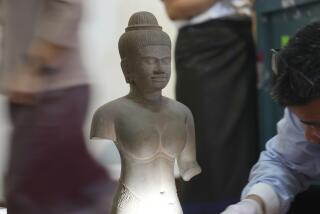Feds pursue Manhattan art dealer suspected of smuggling
- Share via
Federal agents have seized an estimated $100 million in art over the last two years from a prominent Manhattan antiquities dealer they describe as one of the most prolific antiquities smugglers in the world.
Subhash Kapoor, a 64-year-old American citizen, awaits trial in India, where he is accused of being part of an antiquities smuggling ring that American and Indian investigators say spanned continents. U.S. authorities have issued their own arrest warrant for Kapoor, saying they have evidence he supplied stolen art to leading museums around the world.
In a series of raids on his Manhattan gallery and storage facilities last year, investigators with Immigration and Customs Enforcement seized dozens of artifacts along with Kapoor’s business records. Among the objects seized were a 2nd century BC pillar sculpture valued at nearly $18 million and a 5-foot tall head of Buddha weighing approximately 1,600 pounds, investigators say.
Records show that Kapoor provided clients with false ownership histories indicating the objects he sold or donated had been in private collections for decades. Other evidence — including shipping documents and digital images sent to Kapoor by alleged smugglers — show that many of those objects had been recently imported from India and other countries, according to records reviewed by The Times and interviews with people familiar with the probes.
Since 1974, Kapoor and his Madison Avenue gallery Art of the Past have sold or donated ancient art to the Metropolitan Museum of Art in New York City, the Los Angeles County Museum of Art, the Norton Simon Museum, the Asian Art Museum of San Francisco, the Art Institute of Chicago, the Toledo Museum in Ohio and others. Abroad, his clients included the Musée des Arts Asiatiques-Guimet, Paris; the Museum f¿r Indische Kunst in Berlin; the Royal Ontario Museum in Toronto; the Asian Civilisations Museum in Singapore; and the National Gallery of Australia.
To date none of the museums has been accused of possessing stolen art or conspiring with Kapoor. Several have acknowledged having objects from Kapoor but declined to comment on the ongoing investigations.
Kapoor’s attorney, Christopher Kane of New York, did not respond to requests for comment.
The evidence could unravel the biggest antiquities smuggling network identified since the 1990s, authorities say.
PHOTOS: Arts and culture in pictures by The Times
“It’s one of our most significant antiquities and artifacts investigations that we’ve conducted,” Immigration and Customs Enforcement Special Agent in Charge James T. Hayes said in an interview after a raid last year.
The National Gallery of Australia is the first museum to publicly grapple with its ties to Kapoor, in part because American and Indian investigators revealed last July that they had traced a costly stolen sculpture of dancing Shiva to the museum.
Last month, museum director Ron Radford told a committee of Australia’s senate that he was confident the Shiva and some 20 other objects acquired from Kapoor had not been stolen because the museum had ownership histories dating to before 1970.
But detailed records on several objects that Kapoor sold to the National Gallery of Australia show that they were photographed in India and exported from there years after the ownership histories indicated they had left that country — and long after India’s 1972 law prohibited the export of cultural artifacts.
In 2005, Indian investigators say, Kapoor traveled to Tamil Nadu, India, where he asked the alleged head of a ring of idol thieves for prized bronzes from the Chola kingdom, which ruled south India from the 9th to the 13th centuries. Over the next several months, thieves broke into a local temple and stole the Shiva and seven other idols, the investigators say.
The alleged smugglers sent digital pictures of the Shiva to Kapoor in October 2006, documents reviewed by The Times show. The idols were then mingled with replicas, certified as modern handicrafts and shipped to Kapoor’s New York company in the fall of 2006.
PHOTOS: Hollywood stars on stage
Kapoor went on to publish a photo of the Shiva in his catalog, calling it “the largest, most significant Chola Period sculpture of this subject to appear on the market in a generation.” The asking price was $5 million.
Radford, the Australian museum director, saw the statue in New York during a visit with Kapoor, records show. The bronze was shipped to the Australian museum for consideration in October 2007, records show, and the museum asked Kapoor for additional documents.
In February 2008, the records show, Kapoor or someone in his office created a Word document titled “Purchase Invoice, 18 October 2004.” The document was presented as evidence that Kapoor had purchased the Shiva from a Washington, D.C., collector four years earlier, according to the sources familiar with the investigations, who declined to be identified because the inquiries are ongoing.
Soon after, the National Gallery purchased the statue for $2 million U.S., records show, and put its image on the cover of a 2008 annual report. The museum did not respond to emailed requests for an interview with Radford.
More to Read
The biggest entertainment stories
Get our big stories about Hollywood, film, television, music, arts, culture and more right in your inbox as soon as they publish.
You may occasionally receive promotional content from the Los Angeles Times.










